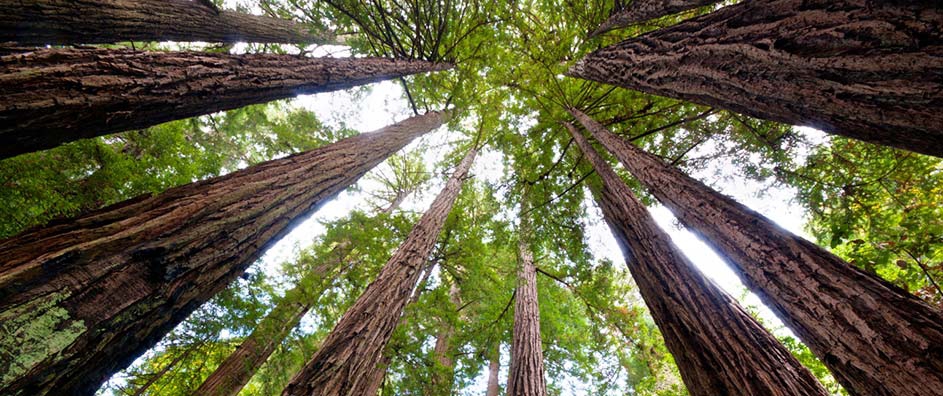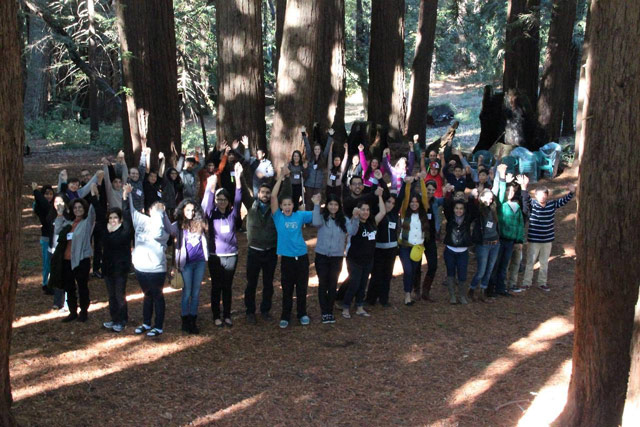The views expressed in our content reflect individual perspectives and do not represent the authoritative views of the Baha'i Faith.
The religion of God is one religion, but it must ever be renewed. – Abdu’l-Baha, Selections from the Writings of Abdu’l-Baha, p. 51.
If one sentence can encapsulate an entire Faith, those thirteen words from Abdu’l-Baha do a remarkable job of summarizing the main thrust of the Baha’i teachings.
This beautiful, startling and truly revolutionary idea sees all religion as a single, linked organic ecosystem. Like a forest of majestic old-growth trees, the Baha’i teachings say all religion sprouts from the same soil and gets its life from the same rain and the same light. When one tree in that ancient forest dies, another rises to take its place.
Since we both love the feeling we get when we walk among big trees, my wife and I got married in just such a forest. On the wooded grounds of the Bosch Baha’i School, in the mountains near Santa Cruz, California, we stood with our friends and family in a circular grove of coastal redwood trees and said our wedding vows.
That incredibly beautiful place, named the Leroy Ioas Grove after one of the earliest American Baha’is, has a magical quality to it. A ring of huge, 200-foot trees surrounds a large open space, and when you stand there you feel as if you’re in the most majestic spot on earth. The rich smells of the forest floor fill your nostrils. The light filters down through the grandfathers—what the ancient people call the biggest trees—and dapples the ground. The birds sing. Squirrels chatter. A breeze gently lufts the branches and their needles. You feel transported, as if you’ve come to your true home, as though nothing manmade can ever match the grandeur of these enormous living beings.
I wondered, when we picked that grove for our wedding, how it grew that way, in such a perfectly symmetrical circle—so I did a little research. I found out that the coastal redwood variety of the genus Sequoia Sempivirens reproduces by sprouting from the stump of a “mother” tree. (That’s kind of misleading, actually, since Sequoias are monoecious, which means they’re plants that bear flowers of both sexes, which makes self-reproduction possible). Anyway, that gigantic original mother/father tree—which, at one time long ago, stood in the center of the same circle we did—stimulated the dormant sprouts under its own bark when its adult trunk suffered damage, or when it began to die.
Which means that the original tree, throughout its life, grows the capacity to go on living.
 When the end of the mother tree’s life approaches, the tree usually dies, decays and falls. New sprouts spontaneously erupt and start to grow around her circumference. Some biologists call the resulting circular formation of trees “fairy rings”—but they’re really a gathering that pays biological homage to their mother/father tree, by surrounding and sheltering its original ground.
When the end of the mother tree’s life approaches, the tree usually dies, decays and falls. New sprouts spontaneously erupt and start to grow around her circumference. Some biologists call the resulting circular formation of trees “fairy rings”—but they’re really a gathering that pays biological homage to their mother/father tree, by surrounding and sheltering its original ground.
In some ways you can think of those trees, not just as the descendants of their progenitors, but as the growth of one continuous, immortal tree. Since the tree reproduces and begins to re-grow even as it dies and decays, it never really dies. In many ways, when you see a giant tree like the coastal redwood, you’re seeing its ancestors, too.
Just as the lifecycle of all living things sprouts from its ancestors and requires a new infusion of energy and creative power to begin again, the Baha’i teachings say religion also requires renewal. True religion, Baha’is believe, is progressive and not static; active instead of passive; ever growing and evolving rather than fossilized and inert:
Religion is the outer expression of the divine reality. Therefore it must be living, vitalized, moving and progressive. If it be without motion and non-progressive it is without the divine life; it is dead. – Abdu’l-Baha, Foundations of World Unity, p. 82.
With this idea in mind, religion itself becomes something completely different than what we’re probably used to thinking about. Instead of a fixed, unchanging set of dogmas and rituals, we can begin to conceptualize religion as an evolving system that allows us to understand our spiritual selves, as a naturally growing and changing force, as a universal reality:
From the seed of reality, religion has grown into a tree which has put forth leaves and branches, blossoms and fruit. After a time this tree has fallen into a condition of decay. The leaves and blossoms have withered and perished; the tree has become stricken and fruitless. It is not reasonable that man should hold to the old tree, claiming that its life forces are undiminished, its fruit unequalled, its existence eternal. The seed of reality must be sown again in human hearts in order that a new tree may grow therefrom and new divine fruits refresh the world. By this means the nations and peoples now divergent in religion will be brought into unity, imitations will be forsaken and a universal brotherhood in the reality itself will be established. Warfare and strife will cease among mankind; all will be reconciled as servants of God. For all are sheltered beneath the tree of His providence and mercy. God is kind to all; He is the giver of bounty to all alike, even as His Holiness Jesus Christ has declared that God “sendeth rain on the just and on the unjust;” that is to say, the mercy of God is universal. All humanity is under the protection of His love and favor, and unto all He has pointed the way of guidance and progress. – Abdu’l-Baha, Foundations of World Unity, p. 84.
In this short series of articles, we’ll explore the Baha’i concept of the organic oneness of all great Faiths; look at the reasons for the renewal of religion; and try to understand how belief systems relate to one another historically, spiritually and biologically.

















Comments
Sign in or create an account
Continue with Googleor